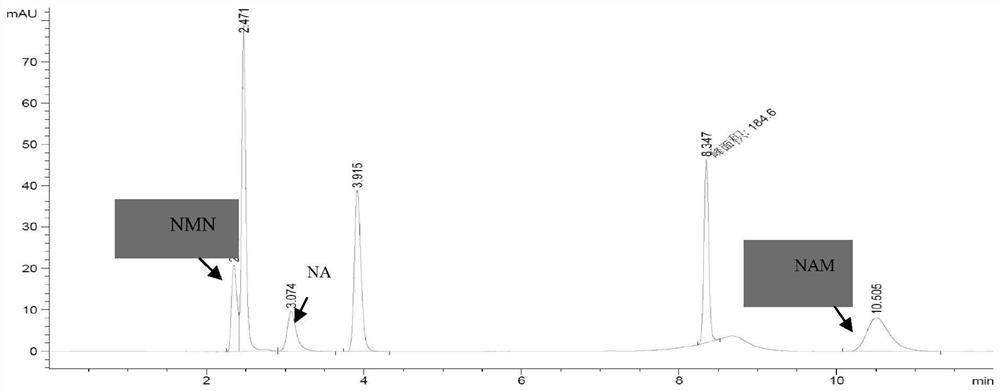Novel recombinant microorganism with NMN synthesis path and production method
A technology for recombining microorganisms and production methods, applied in the direction of microorganism-based methods, biochemical equipment and methods, microorganisms, etc., can solve the problems of difficult to achieve large-scale factory production, large chemical reagent pollution, low enzyme activity, etc., and achieve cost Low cost, low price, simple process effect
- Summary
- Abstract
- Description
- Claims
- Application Information
AI Technical Summary
Benefits of technology
Problems solved by technology
Method used
Image
Examples
Embodiment 1
[0026] Example 1 Artificial synthesis of gene encoding nicotinic acid mononucleotide amidase
[0027] The final step of NAD biosynthesis is NAD synthetase (NadE, EC 6.3.1.5) using ammonia or glutamine as a nitrogen donor to hydrolyze a molecule of ATP and catalyze NaAD to generate NAD. NadE can also catalyze NaMN to NMN, but the substrate preference is very strong, and Escherichia coli's own NadE basically does not catalyze NaMN. Sorci et al. found that there is a nicotinic acid mononucleotide amidase nadE* in Francisella tularensis, which can catalyze NaMN to directly generate NMN, and can also catalyze NaAD to generate NAD, but the substrate preference for NaMN is more powerful. Therefore, the present invention synthesizes nadE* from different microbial sources, hoping to realize the production of NaMN to NMN in Escherichia coli. NaMN in Escherichia coli is an intermediate product of the NAD de novo synthesis pathway, and can be converted into NaMN by exogenously added sub...
Embodiment 2
[0029] Example 2 Overexpression of nicotinic acid phosphoribosyltransferase and nicotinic acid mononucleotide amidase plasmid construction
[0030] In order to quickly convert the exogenously added substrate NA into the NMN synthesis precursor NaMN, it is necessary to overexpress the pncB gene of Escherichia coli itself.
[0031] First construct the expression plasmid pHD28: use the W3110 genome as a template, use the primer pair pHD28-F / pHD28-R to amplify the pncB gene fragment, and after the obtained fragment is recovered, digest it with NcoI-XhoI vector pEZ07 (vector pEZ07 is the same as the Chinese patent application number : 201510093004.3) for seamless cloning (GBclonart seamless cloning kit, Suzhou Shenzhou Gene Co., Ltd.), transformed the host TG1, and successfully constructed the expression plasmid pEZ07-pncB, numbered pHD28, by bacterial liquid PCR and enzyme digestion verification.
[0032] Then, using the synthesized FnnadE*, FtnadE* and MnnadE* gene sequences as t...
Embodiment 3
[0035] Example 3 The method for gene knockout in Escherichia coli
[0036] The present invention adopts Datsenko's method to carry out gene knockout in Escherichia coli (Datsenko 2000.ProcNatl Acad Sci USA, 97 (12): 6640-6645), corresponding gene knockout primer sees Baba 2006.Mol SystBiol, 2 (1) 0008.
PUM
 Login to View More
Login to View More Abstract
Description
Claims
Application Information
 Login to View More
Login to View More - R&D
- Intellectual Property
- Life Sciences
- Materials
- Tech Scout
- Unparalleled Data Quality
- Higher Quality Content
- 60% Fewer Hallucinations
Browse by: Latest US Patents, China's latest patents, Technical Efficacy Thesaurus, Application Domain, Technology Topic, Popular Technical Reports.
© 2025 PatSnap. All rights reserved.Legal|Privacy policy|Modern Slavery Act Transparency Statement|Sitemap|About US| Contact US: help@patsnap.com



